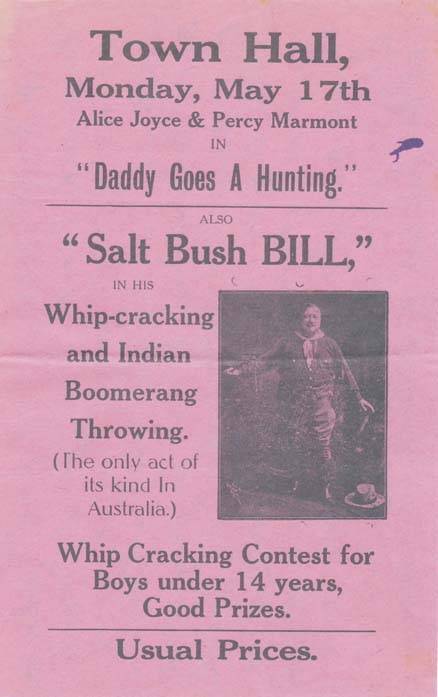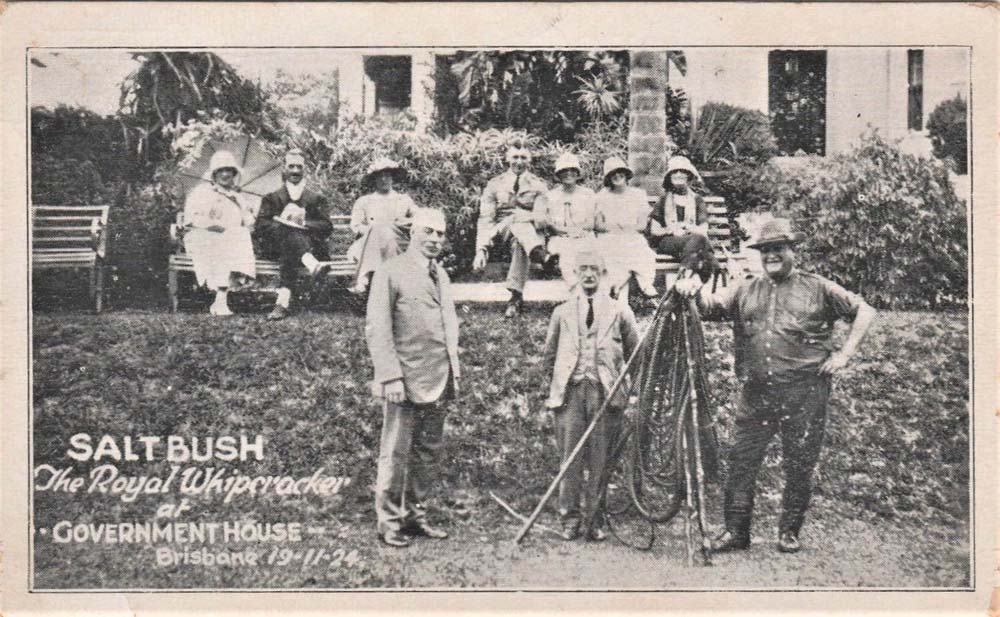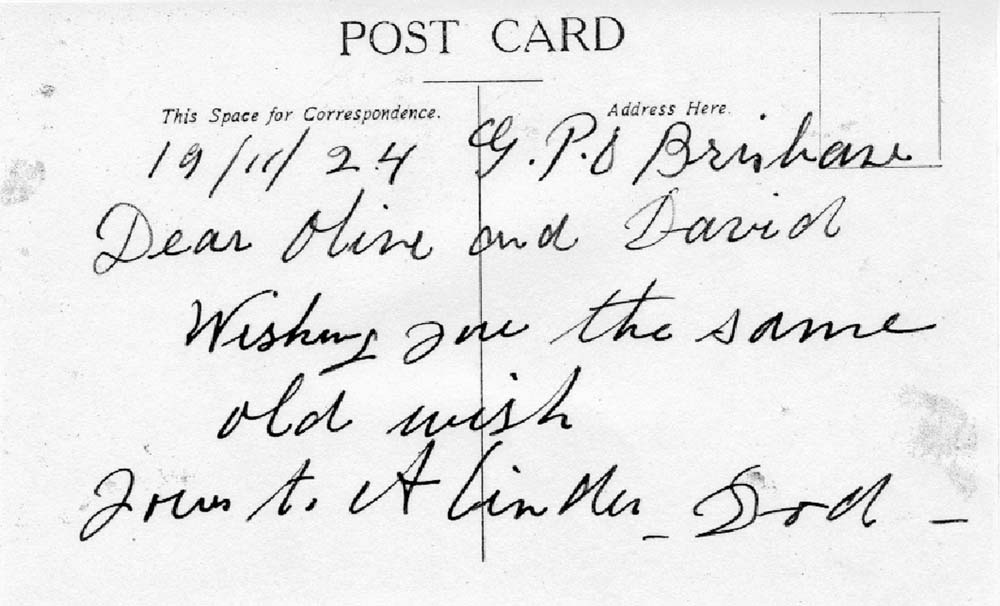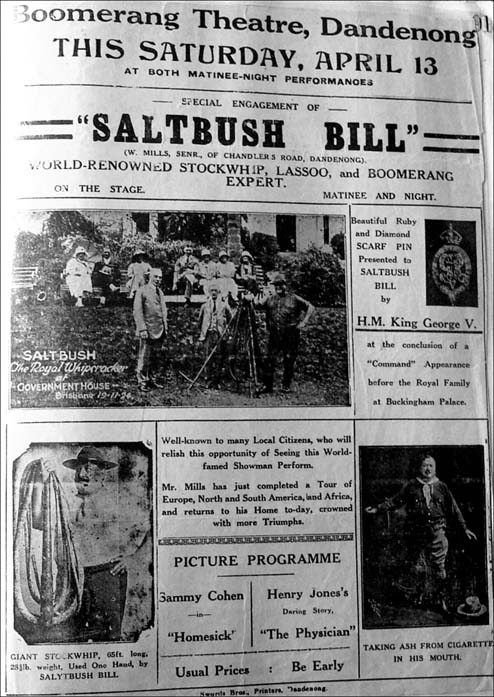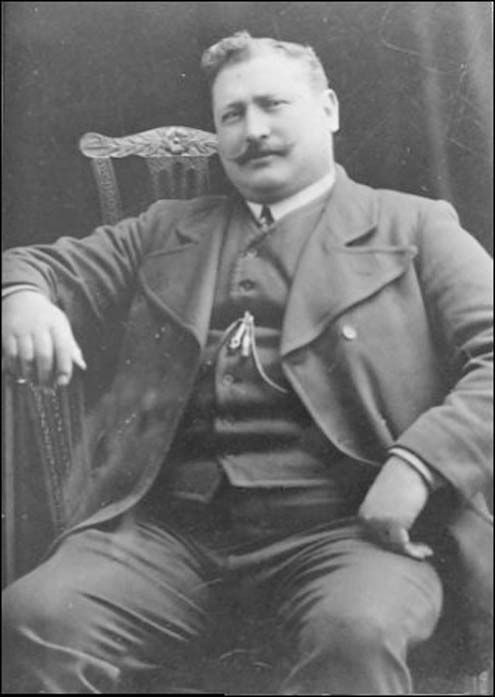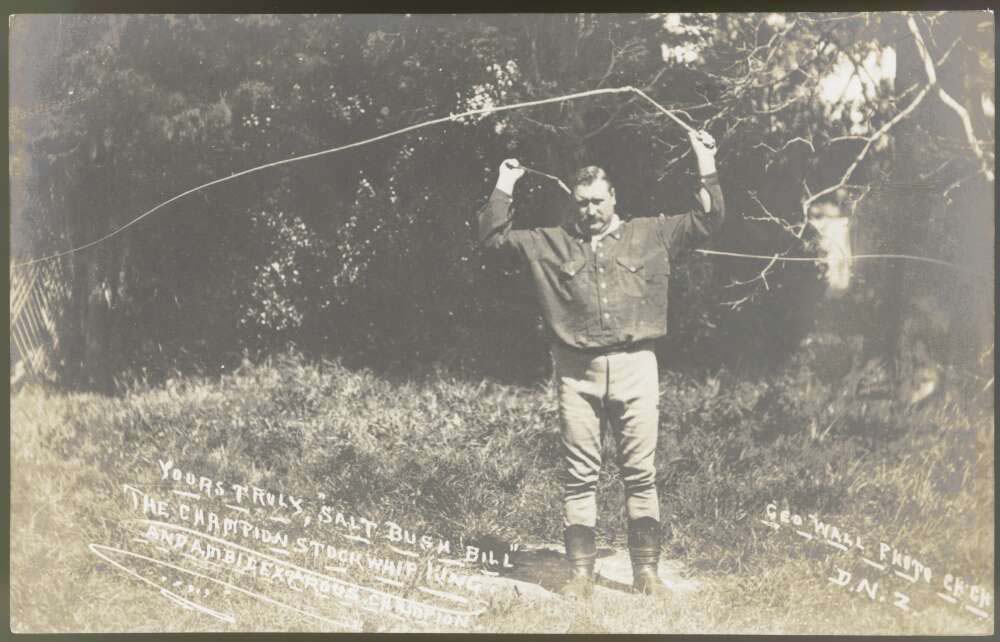
By Ilma Hackett, Balnarring & District Historical Society
When Roderick William Mills was born in Balnarring in 1869 there was nothing to suggest that one day, as ‘Saltbush Bill’, he would thrill audiences world-wide with his whip-cracking skills and even perform for royalty at Buckingham Palace, or that his name would enter folklore through the poems of Banjo Patterson.
The Mills family at Balnarring
Roderick’s grandfather, William Mills, an Englishman from Bedfordshire, arrived in Australia in the 1830s. William worked as a carrier mainly in the Brighton area and in 1847 selected land in Heatherton where he established market gardens. He married a young widow, Mary Denham and the couple raised three sons and a daughter. At the end of 1867 a son, William Jr. (Bill), applied for a lease to land at Balnarring and moved onto lot 34B the following year. The land covered approximately 131 acres and was situated along Stanleys Road in what in now Merricks. By the middle of 1870 a small farm stood on 60 acres of cleared bushland. Bill met an accidental death in 1871 and William Sr. took over the farm. He, Mary and their daughter, Georgina, came to live at Balnarring. Nearby was Newstead, the home of John Oswin, who married Georgina in 1872. When his wife died in 1894, William Sr. lived at Newstead until his death in 1900. The other two sons, Jack and Bob, farmed the Mills’ property in Heatherton and visited Balnarring regularly. Jack had married Mary Carter in 1866 and four of their nine sons were born at Balnarring, including Roderick William who was known as ‘Dod’ to the family.
‘Dod’ becomes ‘Saltbush Bill’
As a fourteen-year-old Dod went to outback Queensland where he worked on a cattle station. An excellent horseman he spent many hours out in the saltbush on his horse. The station owner dubbed him ‘Saltbush Bill’. His exploits as a drover and bushman are said to have provided inspiration for Banjo Paterson when he created his Saltbush character. Paterson’s first poems were published in The Bulletin in 1885 and his bush poetry became highly popular. They were rollicking tales in verse, full of laconic humour that reflected the isolated life of those in the Outback as typified by stereotype characters.
I have gathered these stories afar
In the wind and the rain,
In the land where the cattlemen are
On the edge of the plain
[prelude to The Man from Snowy River and other verses]
Saltbush Bill – by Andrew Barton Paterson
Now is the law of the Overland that all in the West obey —
A man must cover with travelling sheep a six-mile stage a day;
But this is the law which the drovers make, right easily understood,
They travel their stage where the grass is bad, but they camp where the grass is good;
They camp, and they ravage the squatter’s grass till never a blade remains.
Then they drift away as the white clouds drift on the edge of the saltbush plains:
From camp to camp and from run to run they battle it hand to hand
For a blade of grass and the right to pass on the track of the Overland.
For this is the law of the Great Stock Routes, ’tis written in white and black —
The man that goes with a travelling mob must keep to a half-mile track;
And the drovers keep to a half-mile track on the runs where the grass is dead,
But they spread their sheep on a well-grassed run till they go with a two-mile spread.
So the squatters hurry the drovers on from dawn till the fall of night,
And the squatters’ dogs and the drovers’ dogs get mixed in a deadly fight.
Yet the squatters’ men, thought they haunt the mob, are willing the peace to keep,
For the drovers learn how to use their hands when they go with the travelling sheep;
But this is the tale of a Jackaroo that came from a foreign strand,
And the fight that he fought with Saltbush Bill, the King of the Overland.
Now Saltbush Bill was a drover tough as ever the country knew,
He had fought his way on the Great Stock Routes from the sea to the Big Barcoo;
He could tell when he came to a friendly run that gave him a chance to spread,
And he knew where the hungry owners were that hurried his sheep ahead;
He was drifting down in the Eighty drought with a mob that could scarcely creep
(When the kangaroos by the thousand starve, it is rough on the travelling sheep),
And he camped one night at the crossing-place on the edge of the Wilga run;
‘We must manage a feed for them here,’ he said, ‘or half of the mob are done!’
So he spread them out when they left the camp wherever they liked to go,
Till he grew aware of a Jackaroo with a station-hand in tow.
They set to work on the straggling sheep, and with many a stockwhip crack
They forced them in where the grass was dead in the space of the half-mile track;
And William prayed that the hand of Fate might suddenly strike him blue
But he’d get some grass for his starving sheep in the teeth of that Jackaroo.
So he turned and cursed the Jackaroo; he cursed him, alive or dead,
From the soles of his great unwieldly feet to the crown of his ugly head,
With an extra curse on the moke he rode and the cur at his heels that ran,
Till the Jackaroo from his horse got down and went for the drover-man;
With the station-hand for his picker-up, though the sheep ran loose the while,
They battled it out on the saltbush plain in the regular prize-ring style.
Now, the new chum fought for his honour’s sake and the pride of the English race,
But the drover fought for his daily bread with a smile on his bearded face;
So he shifted ground, and he sparred for wind, and he made it a lengthy mill,
And from time to time as his scouts came in they whispered to Saltbush Bill —
‘We have spread the sheep with a two-mile spread, and the grass it is something grand;
‘You must stick to him, Bill, for another round for the pride of the Overland.’
The new chum made it a rushing fight, though never a blow got home,
Till the sun rode high in the cloudless sky and glared on the brick-red loam,
Till the sheep drew in to the shelter-trees and settled them down to rest;
Then the drover said he would fight no more, and gave his opponent best.
So the new chum rode to the homestead straight, and told them a story grand
Of the desperate fight that he fought that day with the King of the Overland;
And the tale went home to the Public Schools of the pluck of the English swell —
How the drover fought for his very life, but blood in the end must tell.
But the travelling sheep and the Wilga sheep were boxed on the Old Man Plain;
’Twas a full week’s work ere they drafted out and hunted them off again,
With a week’s good grass in their wretched hides, with a curse and a stockwhip crack,
They hunted them off on the road once more to starve on the half-mile track.
And Saltbush Bill, on the Overland, will many a time recite
How the best day’s work that he ever did was the day that he lost the fight.
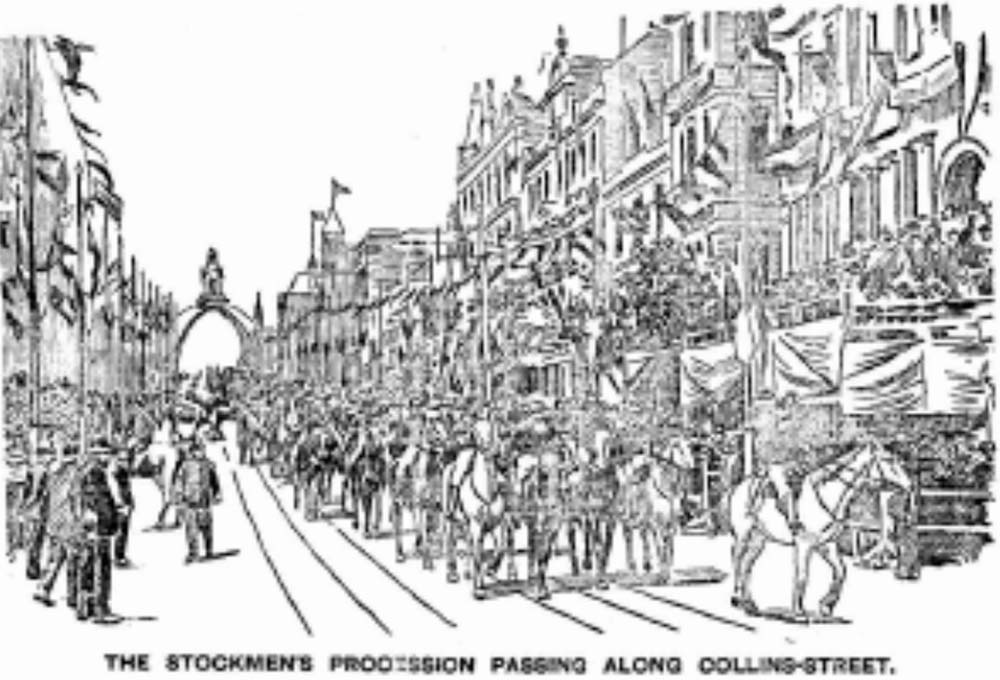
Paterson’s ‘Saltbush Bill’ was first published in 1894. The character was a drover, easy going yet shrewd, knowledgeable in both bush law and lore that he used to his own advantage. Saltbush Bill appeared in five of Paterson’s poems and the name became synonymous with Outback Australia.
In 1888, at the age of 19, Mills had married Hannah Porter and the couple raised eleven children. The family home was at Heatherton where they had market gardens and where their children grew up. Mills’ droving exploits were well-known. He created his reputation as a whip-cracker, and won £100, when he successfully cracked a 65 ft (19.8m) whip believed to be the world’s biggest stock whip. The money had been offered by Melbourne saddler, J. K. Jennings to the first person who could crack the whip, which he had in his Melbourne store, in three attempts. ‘Saltbush’ did it on the first. The feat was so impressive that Mills became an instant celebrity. His skill with the whip had earned him big money.
Federation celebrations
In 1901, when the Duke of York visited Australia to open the first Federal Parliament, one of the events organised for the occasion was a Procession of Stockmen through the streets of Melbourne, ending at Government House where a demonstration of whip cracking and rough riding for the royal party took place. The stockmen, resplendent in red shirts, neat black leggings, spotless white moleskin breeches and ‘wideawake’ brown hats, were called by the Press “men from Snowy River”, echoing Paterson’s popularity at the time. Mills was one of the 200 or so riders who rode through the streets cracking their whips and calling ‘cooee’ and, according to later claims, the Duke was so impressed with his display with the whip that he invited ‘Saltbush Bill’ to call on him should he ever travel to England. However it should be noted that an account of the demonstration in The Argus mentions the exhibition of stock-whip cracking by Dan Hassett, ‘Whip Cracking Champion of the World’.
In fact the royal demonstration was to be a turning point for Mills. He realised that money could be made from wielding the stock whip for appreciative audiences and he entered show business. ‘Saltbush Bill’ became his show name.
From stockman to showman
Saltbush Bill joined a Western Australian buckjumping outfit that toured Australia and the Commonwealth. He was with Martini’s Buckjumpers in 1906 when he was taken to court by Martin Breheny, owner of the outfit, over the ownership of a whip. Bill used his own stock whips in the show but a ‘Henderson’s monster stock whip’, 54 ft long, had been purchased by Breheny to use in the show after Bill had negotiated its sale from Henderson, a Sydney saddler. When Mills left the outfit he took the whip with him believing it was his. Mills lost the case and the whip was returned.
In 1908 he was at Oamaru in New Zealand with O’Neill’s Buckjumpers. He also gave an impromptu show to his Balnarring cousins and neighbours when he visited Newstead, the Oswin homestead, briefly in April 1908. His aunt, Georgina Oswin, wrote in her diary: Dod gave an exhibition of whip cracking this a.m. He had quite a crowd of spectators but he did not do anything very clever – his whips were not right. [The Oswin Diaries 1880 – 1910 by Mary Karney. 1990]
Later he abandoned the rough riding shows for vaudeville. For appearances on stage he had to adjust his act. The 30 ft (9 metre) whip proved to be awkward and damaging to manage in a confined space but a 20 ft (6 metre) one allowed him to perform feats such as snuffing out a candle. In 1909 he was performing at shows throughout Queensland and N.S.W. He performed at the Royal Agricultural Show in Sydney, and the Jubilee Carnival in Brisbane. A private performance at Government House in Sydney was given for Lord Dudley, the Governor- General.
One reviewer wrote in The Queenslander [22 May, 1909]: Bill is an unassuming and straightforward bushman with a little of the backblocks worn off perhaps by his stage experiences but no-one meeting him at the tail of a mob of cattle with stock whip in hand could mistake him for other than a genuine ‘cattle puncher’.
During his act he demonstrated his dexterity with whips of different lengths and different styles and performed feats such as cutting a cigarette out of his own hand and knocking ash from a cigarette in his own mouth. He could use the whip skillfully with either hand. A big man, 6 ft 2 tall, powerful and more solidly built than in his droving days, he made an impressive figure on stage armed with his whip.
In 1910 Saltbush Bill was advertising himself on his professional card as “Champion Stock Whip Cracker of Australia”.
Command performance
In 1912 he toured the U.K with Bostock’s “Wild Australia”, a government-sponsored tour to promote Australia. The show included cattle mustering, wood chopping, boomerang throwing, whip cracking and bushranging. Audiences were enthralled. Saltbush had to be warned not to frighten prospective emigrants with stories of alligators and snakes and suggesting carpet-snake meat was a regular item of diet in Australia. The English Press publicised the show and King George V, recalling the display of whip cracking in Melbourne in 1901, invited Saltbush Bill to perform at Buckingham Palace.
The Warrick Examiner and Times [Queensland], among other Australian newspapers, described the event in detail. The audience, about 150 people all told, included George V and Queen Mary, Queen Alexandria, the Prince of Wales, Princess Mary and Princess Victoria. Members of their suites watched and as many of the royal servants who could be spared from other duties. With Saltbush Bill was the young lady who assisted him in his performance. He flicked a cigarette from her mouth with his whip and cut a lighted match from her hand. She subjected herself to being lassoed around the neck with the thong of two whips, one being used with one hand and the second with the other. She was then drawn towards him, to show how securely she had been ‘roped’ and not a mark appeared on her skin. Mills was dressed to look the part. He wore ‘jackboots, a scarlet shirt and a knotted muffler around his neck’. After a full routine of tricks he performed his finale, cracking out several bars of “God Save the King” on his 65-foot whip. The whip-cracking, which was held indoors in the ballroom, was followed by a display of boomerang throwing in the palace gardens. In appreciation, the King presented him with a gold pin, featuring the royal cipher, set with rubies and diamonds. Saltbush presented the king with one of his handmade stock whips and suggested that whip cracking was a fine form of healthy morning exercise that developed the muscles. It did become a fashionable diversion for a period.
The war years
Saltbush Bill toured England, Ireland, Scotland, France and Germany presumably before the outbreak of the war in Europe. In April 1915 Bill returned to Australia from North America where he had been present at the Panama exhibition. America didn’t impress him – “a land of slavery and graft” [Armidale Express & New England General Advertiser 13 April, 1915] and gave his opinion that Australia was the best country in the world.
He was back in the U.S. towards the end of 1915 to give shows in Vancouver, Portland, ‘in and about’ Seattle and San Francisco. In 1917 Mills returned to London from America, possibly sailing on a U.S. mercantile marine ship as the U.S. had now entered the war. In a letter to a friend in Sydney he wrote that he was there to spend time with his two sons who were serving with the AIF and were on leave from the French Front. He wrote, “I can’t get out now and shall have to stay till the war is over”. While in England he gave many charitable performances for the war effort.
When Edward, Prince of Wales sailed to Australia in 1920 aboard HMS Renown to thank the Australian people for their part in World War 1, Saltbush Bill tried to get a berth aboard the same ship. He aimed to teach the Prince the art of whip cracking so that he might be at home when he toured country Australia. His bid was unsuccessful. The Adelaide Daily Herald reported his return from the U.K. in June, 1920 on board the Horarata, describing Bill as “one of the most skilful handlers of the Australian stockwhip that this country has ever produced”.
Top: Advertisement for a Queensland performance.
Middle: Postcard of performance at Government House, Brisbane, 1924.
Bottom: Short message to Balnarring cousins, written on the reverse side of the Government House postcard.
Points of contention
Banjo Paterson’s poems were often loosely based on a particular individual and there were often multiple claims as to who that individual actually was. Paterson generally refused to disclose the identity of his characters. In some cases, such as the Man from Snowy River, there was a degree of certainty, although in spite of a statue to Jack Riley erected in Corryong, there were others who
claimed the title. In some instances such as The Man from Ironbark or Mulga Bill, it was anybody’s guess.
But what of Saltbush Bill? The nickname had been given to Mills as a young stockman in the outback and he took it with him into the world of show business. Saltbush Bill had a long career in which he performed with many well-known groups including Circus Sarrisani, Barnum & Bailey and the Ringling Brothers. Performances were given at many world-renowned venues such as the London Hippodrome. He visited the British Isles, Holland, the Scandinavian countries, France, Germany, India, South Africa, North and South America and New Zealand. Wherever Saltbush Bill went he received accolades. Newspaper reporters gave rave reviews and often acknowledged him as ‘The Greatest Whip Cracker in the World’
Stockman, Dan Hassett, was greatly annoyed by this recognition. In a brief letter to the Brisbane Truth in 1912 he claimed the title as his and pointed out he had been the only whip-cracker to perform at the 1901 celebrations. Hassett, from around Benalla in Victoria, was a stockman well known for his incredible ability with the stock whip. He had worn the title of Champion Whip-Cracker of Australia, if not the world, for many years.
Much later, during the 1930s, in a much longer article he accused Saltbush Bill of trading on his, Hassett’s, name and reputation to wrangle an invitation to perform for royalty at Buckingham Palace. He was incensed by one column in a country newspaper which stated that Mills had been his tutor. He claimed that the reverse was true. He described Saltbush as a ‘third-rater’ when it came to handling a whip and added he didn’t wish to associate with Saltbush in any way.[Narromine News and Trangie Advocate, 12 June 1931]. Although Hassett did give exhibitions and demonstrations he was not a showman. His skill was mainly with the stock whip, a shorter whip, 9 to 15 ft in length, over which he had complete mastery. He deeply resented the champion title being conferred on Mills.
An obituary written in 1922 claimed that a stockman named Charles Moore was the inspiration for Banjo Paterson’s Saltbush Bill. A drover, his story of an incident along a stock route was very similar to the prolonged fight described in the poem ‘Saltbush Bill’, when a stockman and a station jackeroo came to fisticuffs over the right to graze moving stock on more than a half-mile strip along the roadside. Moore had been moving cattle not sheep but the outcome was the same. The animals had grazed most of the day over a wide area while the fight was in progress.
Above left: Advertisement for ‘Saltbush Bill’s’ final appearance at Dandenong.
Above right: Roderick Mills, aka ‘Saltbush Bill’.
Back for good
During the early years of the 1920s, Mills now in his 50’s, was touring the southern states of Australia. In the mid 1920’s he was back in Queensland performing in Brisbane and Rockhampton. He demonstrated his skills at Government House in Brisbane for the governor, Sir Matthew Nathan, in 1924. In 1927 he was at the tropical Theatre in Cairns. The following year he was on stage in the towns of Grafton and Lismore in N.S.W.
In 1926 Saltbush sent a letter from Brisbane to his Balnarring cousin, Olive (Oswin) Robb. Some of the pages are written on the reverse side of flyers for two coming shows in which he was to perform. His letter includes an incident worthy of any of Paterson’s characters:
Here is a bit of a joke. I was sitting in the [restaurant] house Saturday night having a bit of tea. When I got up to leave my hat was gone from the rack. A fine cowboy hat I gave four pound ten for it, with a horse hair band worth thirty bob on it. I went and reported it at the CI branch close by and went to the Savoy Hotel to get anouther [sic]. As I was passing along Edward Street I saw a fellow go into a hotel wearing my hat. I followed him and heard him offer it for sale for ten bob. I caught him a good hard jolt sideways which settled him and I picked up my hat. He jumped up and said I’ve been looking all over the town to give it to you. I said ‘Oh yes you are a friend of mine’ and gave him anouther [sic] beaut and left him laying there. I had to hurry as I had outher [sic]business to attend to.
In the late 1920s ‘Saltbush’ turned his back on show business and remained home with his family in the Dandenong area. His last performance on stage was held at Dandenong’s Boomerang Theatre. Roderick William Mills died in 1940 at the age of 71 years.
Other ‘Saltbush Bill’ characters
The ‘Saltbush Bill’ name lived on. There were others who adopted it, such as a travelling troubadour in the 1950’s. This singing Saltbush Bill went from town to town performing for rural audiences.
In1924 a comic strip titled, ‘The Adventures of Saltbush Bill’, appeared in The Herald newspaper. This followed the fortunes of a swagman by the name of Saltbush Bill as he travelled through outback areas.
Later, Eric Jolliffe created his Saltbush Bill, a simple bushman plagued by continual mishap, who lived with his family on a rather rundown rural property somewhere in the Outback. He was a dinkum Aussie battler with a deadpan sense of humour, a comic figure whose portrayal upset some of Mills’ descendants.
Jolliffe fell under the spell of Northern Australia and the Outback when, like Mills, he had left home in his mid teens to work and travel through outback N.S.W. and Queensland. He later captured its spirit, not in words as Paterson had done but in illustration – drawings and cartoons. His work was highly popular from the late 1940’s onwards. He helped keep alive the name ‘Saltbush Bill’ first given to a lad born in Balnarring.
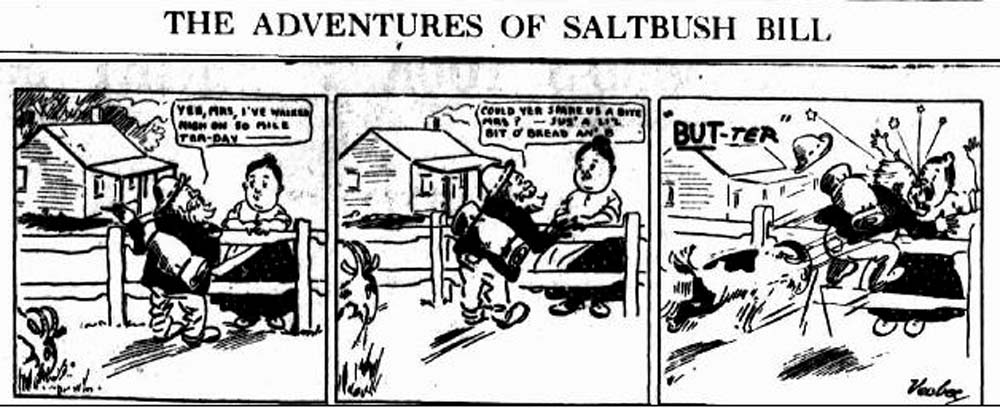
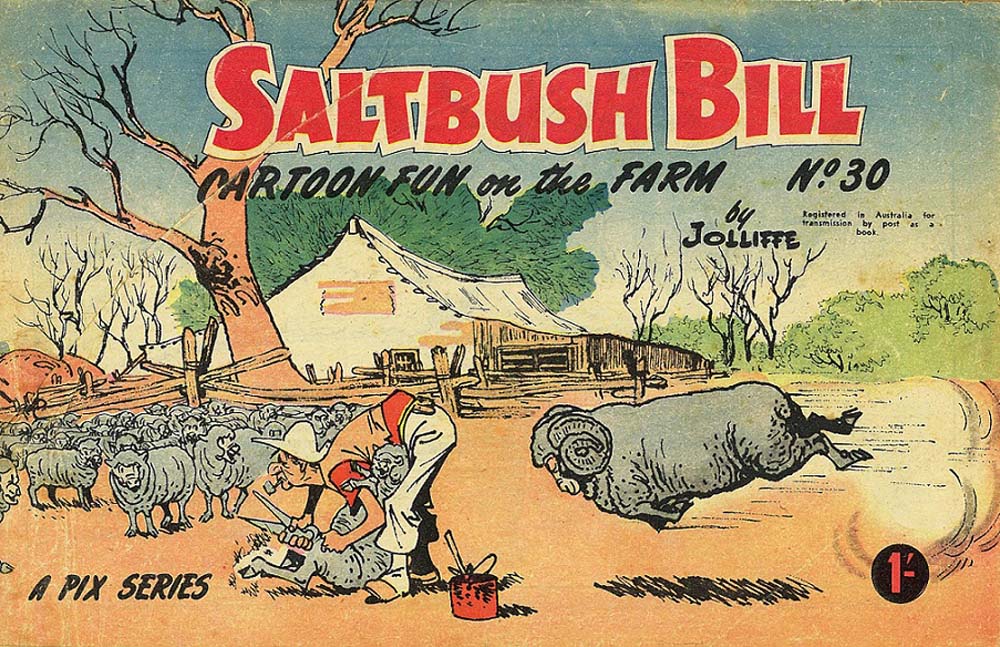
The tie pin
The tie pin presented to Saltbush Mills was made of gold and set with diamonds and rubies. It displayed the royal monogram, GR, within an oval surmounted by a crown. Mills was immensely proud of it, stating he would not sell that tie-pin for a thousand pounds. The pin became a family heirloom. It was converted into a ring for one of his daughters and is now in the possession of a great-grand-daughter.
His whips
Saltbush Bill used a variety of whips of different lengths and weight to demonstrate his skills. His longest whip was the 65 ft (20 metre) “National Anthem” whip that weighed 281/2 lbs (13kg). Many of the whips he used he made himself from bullock hide. One reporter who saw him perform in Kalgoorlie in 1920 described them thus: Coiled up some of his whips look like veritable boa-constrictors: nevertheless when Saltbush Bill sets them going they curl and twist with serpentine rapidity at the will of the operator. At the end of his career his collection consisted of some 150 whips. Only two are still with the family.
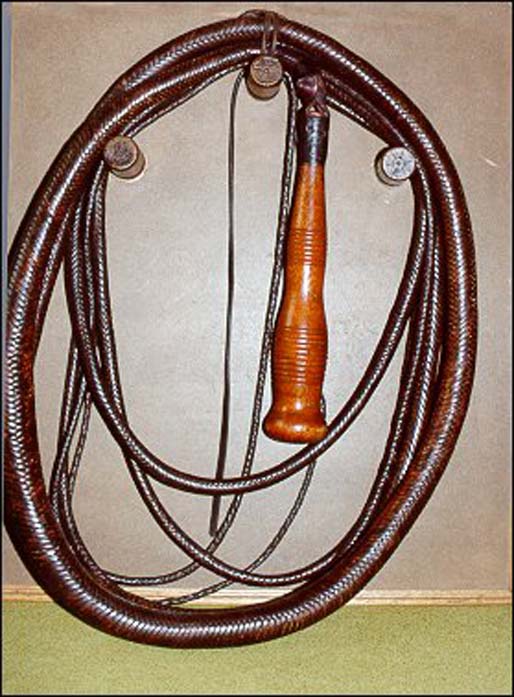
It was reported that two whips were with his Balnarring relatives but there is nothing to support this claim.
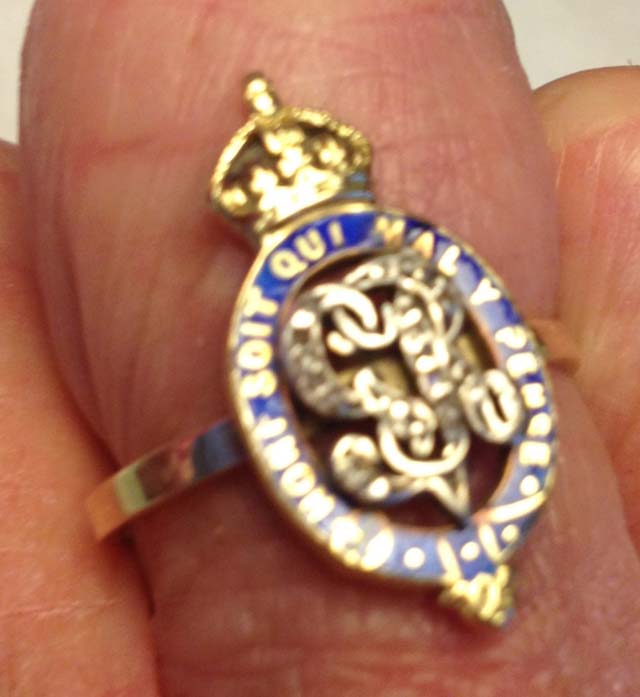
References:
- My Famous Grandfather: A history of Roderick William Mills mss by Sylvia Roberts. Courtesy: Dandenong Historical Society.
- Mary Karney, grand-daughter of Georgina (Mills) Oswin
- Articles from various contemporary newspapers
- Diaries of Georgina Oswin and Family 1881 – 1910. by Mary Karney. 1990
- Photographs from Kingston H.S. – used with permission from a Mills family member. Photo of the ring supplied by its present owner.
- Postcards and brochures from Mary Karney – used with permission.

